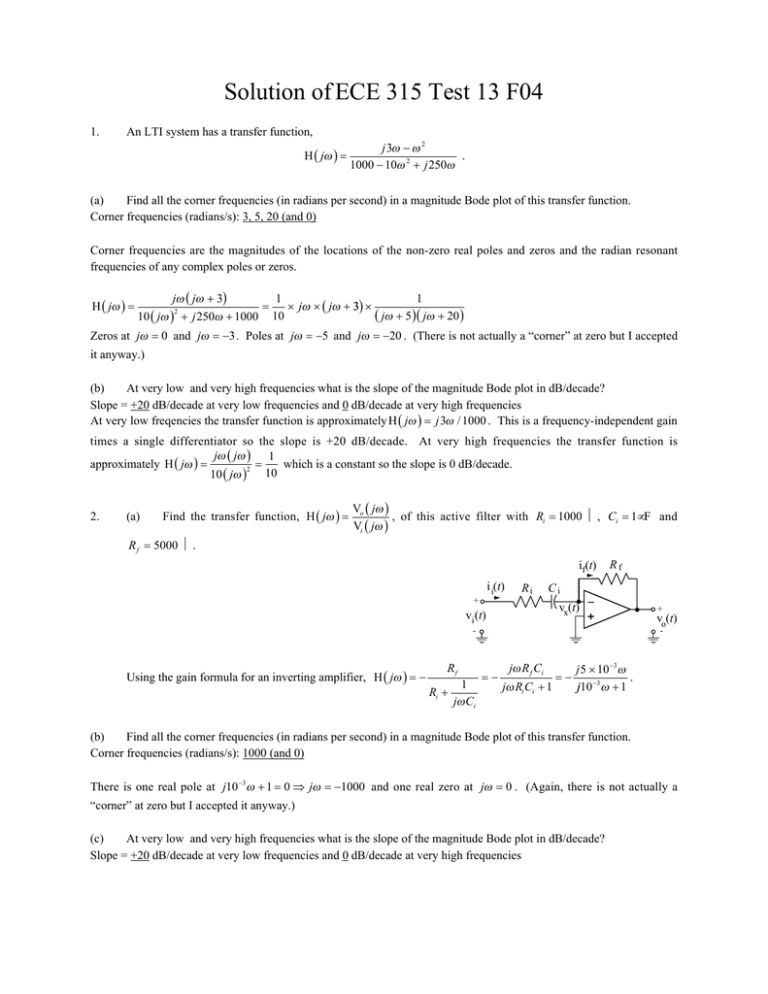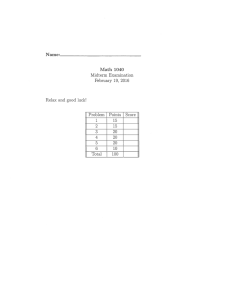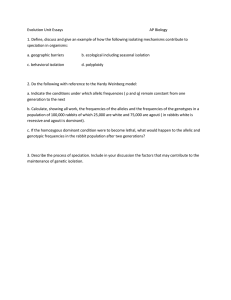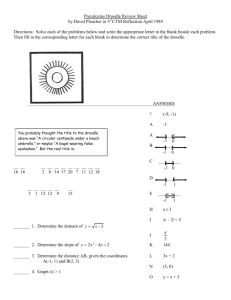Solution of ECE 315 Test 13 F04 ( )
advertisement

Solution of ECE 315 Test 13 F04 1. An LTI system has a transfer function, H ( jω ) = j 3ω − ω 2 . 1000 − 10ω 2 + j 250ω (a) Find all the corner frequencies (in radians per second) in a magnitude Bode plot of this transfer function. Corner frequencies (radians/s): 3, 5, 20 (and 0) Corner frequencies are the magnitudes of the locations of the non-zero real poles and zeros and the radian resonant frequencies of any complex poles or zeros. H ( jω ) = jω ( jω + 3) 10 ( jω ) + j 250ω + 1000 2 = 1 1 × jω × ( jω + 3) × 10 ( jω + 5 ) ( jω + 20 ) Zeros at jω = 0 and jω = −3 . Poles at jω = −5 and jω = −20 . (There is not actually a “corner” at zero but I accepted it anyway.) (b) At very low and very high frequencies what is the slope of the magnitude Bode plot in dB/decade? Slope = +20 dB/decade at very low frequencies and 0 dB/decade at very high frequencies At very low freqencies the transfer function is approximately H ( jω ) = j 3ω / 1000 . This is a frequency-independent gain times a single differentiator so the slope is +20 dB/decade. At very high frequencies the transfer function is jω ( jω ) 1 approximately H ( jω ) = which is a constant so the slope is 0 dB/decade. 2 = 10 10 ( jω ) 2. (a) Find the transfer function, H ( jω ) = Vo ( jω ) , of this active filter with Ri = 1000 Ω , Ci = 1µF and Vi ( jω ) R f = 5000 Ω . if(t) i i(t) Ri Rf Ci + vx(t) vi (t) - Using the gain formula for an inverting amplifier, H ( jω ) = − Rf Ri + 1 jω Ci + vo(t) - =− jω R f Ci jω Ri Ci + 1 =− j 5 × 10 −3ω . j10 −3ω + 1 (b) Find all the corner frequencies (in radians per second) in a magnitude Bode plot of this transfer function. Corner frequencies (radians/s): 1000 (and 0) There is one real pole at j10 −3ω + 1 = 0 ⇒ jω = −1000 and one real zero at jω = 0 . (Again, there is not actually a “corner” at zero but I accepted it anyway.) (c) At very low and very high frequencies what is the slope of the magnitude Bode plot in dB/decade? Slope = +20 dB/decade at very low frequencies and 0 dB/decade at very high frequencies At very low freqencies the transfer function is approximately H ( jω ) = − j 5 × 10 −3ω . This is a single differentiator times a frequency-independent gain of −5 × 10 −3 so the slope is +20 dB/decade. At very high frequencies the transfer function is approximately H ( jω ) = −5 which is a constant so the slope is 0 dB/decade. Solution of ECE 315 Test 13 F04 1. An LTI system has a transfer function, H ( jω ) = 1200 − 10ω 2 + j 340ω . j 6ω − ω 2 (a) Find all the corner frequencies (in radians per second) in a magnitude Bode plot of this transfer function. Corner frequencies (radians/s): 6, 4, 30 (and 0) Corner frequencies are the magnitudes of the locations of the non-zero real poles and zeros and the radian resonant frequencies of any complex poles or zeros. H ( jω ) = 10 ( jω ) + j 340ω + 1200 1 1 = 10 × ( jω + 4 ) ( jω + 30 ) × × jω ( jω + 6 ) jω jω + 6 2 Zeros at jω = −4 and jω = −30 . Poles at jω = 0 and jω = −6 . (There is not actually a “corner” at zero but I accepted it anyway.) (b) At very low and very high frequencies what is the slope of the magnitude Bode plot in dB/decade? Slope = -20 dB/decade at very low frequencies and 0 dB/decade at very high frequencies At very low freqencies the transfer function is approximately H ( jω ) = 200 / jω . This is a frequency-independent gain times a single integrator so the slope is -20 dB/decade. At very high frequencies the transfer function is approximately H ( jω ) = 10 which is a constant so the slope is 0 dB/decade. 2. (a) Find the transfer function, H ( jω ) = Vo ( jω ) , of this active filter with Ri = 2000 Ω , C f = 1µF and Vi ( jω ) R f = 4000 Ω . if(t) i i(t) + Rf Cf Ri vx(t) vi (t) + vo(t) - Using the gain formula for an inverting amplifier, H ( jω ) = − Rf + 1 jω C f Ri - =− jω R f C f + 1 jω Ri C f =− j 4 × 10 −3ω + 1 . j 2 × 10 −3ω (b) Find all the corner frequencies (in radians per second) in a magnitude Bode plot of this transfer function. Corner frequencies (radians/s): 250 (and 0) There is one real zero at j 4 × 10 −3ω + 1 = 0 ⇒ jω = −250 and one real pole at jω = 0 . (Again, there is not actually a “corner” at zero but I accepted it anyway.) (c) At very low and very high frequencies what is the slope of the magnitude Bode plot in dB/decade? Slope = -20 dB/decade at very low frequencies and 0 dB/decade at very high frequencies At very low freqencies the transfer function is approximately H ( jω ) = −500 / jω . This is a single integrator times a frequency-independent gain of −500 so the slope is -20 dB/decade. At very high frequencies the transfer function is approximately H ( jω ) = −2 which is a constant so the slope is 0 dB/decade.





